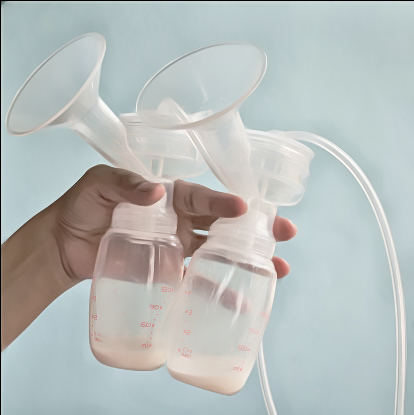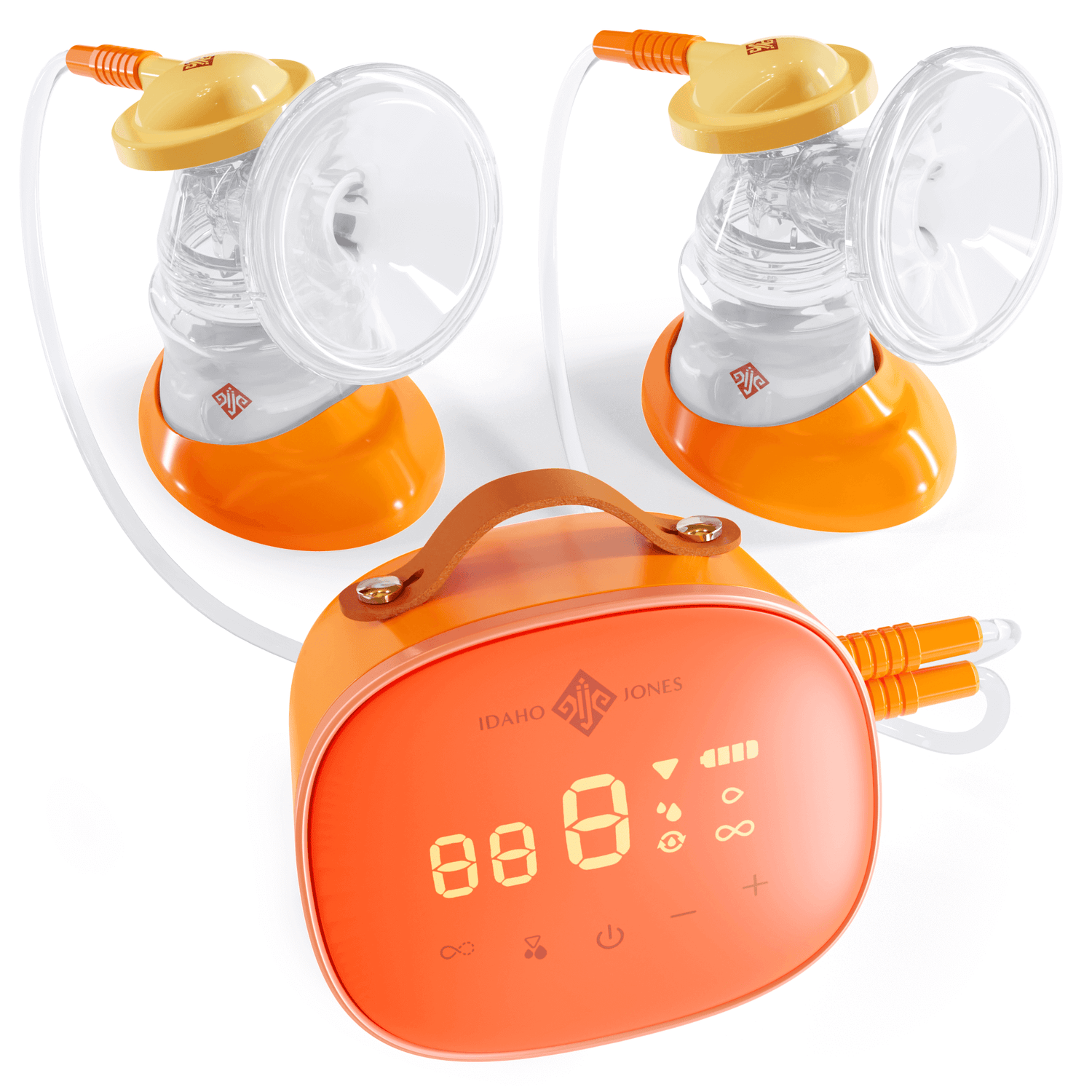
How Much Milk Should I Be Getting When I Pump?
Share
Pumping output can be a source of stress for many moms. It’s easy to wonder what’s normal, and if you should be making more or less. Some people who pump often or exclusively are hesitant to shift to more frequent feeds at the breast—even with the go ahead from their lactation consultant or other care providers—because measuring exactly how much milk you’re getting (and just how much the baby is eating!) can be reassuring. For other moms, watching milk drip, spray, or flow into your pump can be anxiety-inducing, and measuring every drop can be a source of self-doubt.
The goal of this post is to offer an understanding of what is normal, to answer the common question: how much milk should I pump in a session? Keep the following in mind as you consider your pumping output and what’s “normal”:
- “Normal” is a range. You might be anywhere in (or just outside of) that range of normal, and that doesn’t mean anything is wrong.
- Pumping output does NOT necessarily equal breastfeeding output. If all is going well, babies are amazing at removing milk from the breast, and will often remove more than you’ll get with a pump.
- Every session is different. Though tracking the trends in your breastfeeding and pumping data can be helpful in painting an accurate picture of your supply, one pump session, or even a day’s worth of pumping sessions isn’t everything. Each pump, each feed, each day is different, because of your baby, your hormones, your menstrual cycle, your stress levels, your diet and hydration, and everything in between.
That being said, for a mother who exclusively breastfeeds, it’s normal to pump between 0.5-2 ounces/pump session (total, from both breasts combined). Many people aim for or expect to pump 4-8 ounces per session, but this is a large amount and is typically only produced by people who have an oversupply, respond especially well to a breast pump, or have worked to build milk supply by pumping. When you think that every pumper has a deep freezer full of expressed milk or notice the full milk collection containers on a social media mom’s post, know that more often than not, you’re seeing a much larger than “normal” milk supply in action.
The factors below affect milk output, so when you’re wondering about the amount you pumped in a particular session, take a moment to consider the following:
- Baby’s age
- Breastfeeding exclusivity
- Time since your last breastfeeding or pumping session
- Time of day
- Mom’s emotional state
- Breast storage capacity
- Pump quality and fit
Focusing first on age, here are some guidelines around what to expect of your milk supply during the first months of your baby’s life and beyond:
During the First 4-6 Weeks
In this early postpartum phase, you’re likely to see less milk output as your milk supply gradually builds and regulates. As outlined in this post from leading International Board Certified Lactation Consultant (IBCLC), Nancy Mohrbacher, milk production dramatically increases from about one ounce (30 mL) on Day 1 of baby’s life to a peak of about 30 ounces (900 mL) per baby around day 40 of their life. Expect to get less milk from a pumping session in the early days postpartum.
However, even though you may not pump much in a session, your baby also eats less in these first few weeks of life, so you may find yourself with more milk than your baby needs or will drink in a day. Over the first few weeks and months, your supply will regulate to meet your baby’s needs, so enjoy the extra if you have it during these first couple of weeks and don’t worry if you notice a drop in supply a little later down the road.
Pumping in the first 4-6 weeks postpartum can be an important way to build and protect your milk supply, especially in cases of separation from your infant, tongue or lip ties that affect milk transfer, or other issues that cause you to need to pump. Some moms end up “triple feeding” during this time—a demanding rhythm of direct breastfeeding, pumping, and syringe, cup, spoon, or bottle feeding—in an effort to both get your baby the milk they need, while also protecting your milk supply and continuing to help them learn to feed at the breast.
1-6 Months Postpartum
As you get further along in your pumping and breastfeeding journey, you’re likely to notice variations in your output due to a variety of factors. Generally, if you are exclusively pumping, you’ll pump 24-36 ounces in a 24 hour period during this time period. If your baby also directly breastfeeds and you know that they’re able to transfer milk (if you’re not sure about this, see a lactation consultant who can help measure the amount of milk a baby consumes in a particular feed, as well as troubleshoot issues), you will likely pump less than that in a day. If your baby has recently nursed then your pumping output is likely to be lower. As stated previously, 0.5 to 2 ounces total is normal for a pumping session.
Your milk supply can change or dip as you start to spend more time away from your baby, and some parents notice fluctuations in milk output if they return to work during this time. KellyMom points out that “the ability to measure how much milk you are pumping makes any decrease in pumping output more obvious and more worrying, even when it’s a normal variation.” If you notice a decrease in output, consider factors such as menstruation, stress, time away from your baby, or hydration.
6+ Months Postpartum
Much of the information about the first 1-6 months postpartum applies beyond then as well. According to KellyMom, “No pump can remove milk from the breast as well as an effectively nursing baby, so pumping does not maintain milk supply as well as a nursing baby. Because of this, the greater the percentage of baby’s nourishment provided by pumping (rather than direct breastfeeding), the greater the possibility that you may have to work harder to maintain supply.”
The return of menstruation is difficult to predict and quite variable between breastfeeding mothers, but generally, the duration and frequency of feeding (and specifically breast stimulation) affect when someone’s period returns. Many pumping moms notice a return of fertility during this time or even before. Menstruation often lessens milk production in the first few days of the cycle, and you may notice its effects on your pumping output.
That being said, many moms exclusively pump for 12+ months and are able to make all the milk their baby (or babies!) needs, and sometimes even more. For mothers who are doing some pumping and some breastfeeding, you’ll likely notice that on days when your child nurses more, you may get less pump output.
Signs of Oversupply and Undersupply
As you evaluate the amount of milk you are pumping, it can be helpful to know the signs of over and undersupply so that you can know what’s normal (and what’s not) and seek help if necessary. Both over- and undersupply can cause issues for both you and your baby, and can range from being a minor irritation to a big struggle.
Signs of oversupply include (adapted from La Leche League):
- Baby is restless during the feeding
- Baby pulls on and off the breast during the feeding
- Baby coughs, chokes, sputters, or gulps quickly at the breast, especially with letdown
- Baby bites or clamps down at the nipple to try to stop or slow the rapid flow of milk
- Sore, creased nipples (due to the above)
- Baby arches or stiffens, often with painful cries
- Breastfeeding sessions feel like a struggle or battle
- Feedings are short and frequent
- Green, loose, or explosive stools for baby
- Baby is gassy
- Baby spits up frequently
- Strong, forceful milk release, also known as Overactive Milk Ejection Reflex (OMER)
- Excessive leaking from the side where the baby is not feeding
- Breasts never feel fully empty and seem to refill very quickly after a feeding
- Frequent plugged ducts or mastitis
Equally important to understand, signs of undersupply include:
- Baby is not gaining weight at a normal rate
- Baby does not have normal diaper output (after the first week, 6-8 wet diapers and 1-3 dirty diapers at least the size of a quarter in a 24 hour period)
If you’ve got questions about the amount of milk you pump, chances are you are well within the range of normal. If you aren’t sure, or are struggling with milk supply, you can reach out to a lactation consultant or peer support group for support in your specific situation. The amount of milk you pump and produce will likely vary as your baby grows and your body regulates and recovers from pregnancy and early postpartum.


